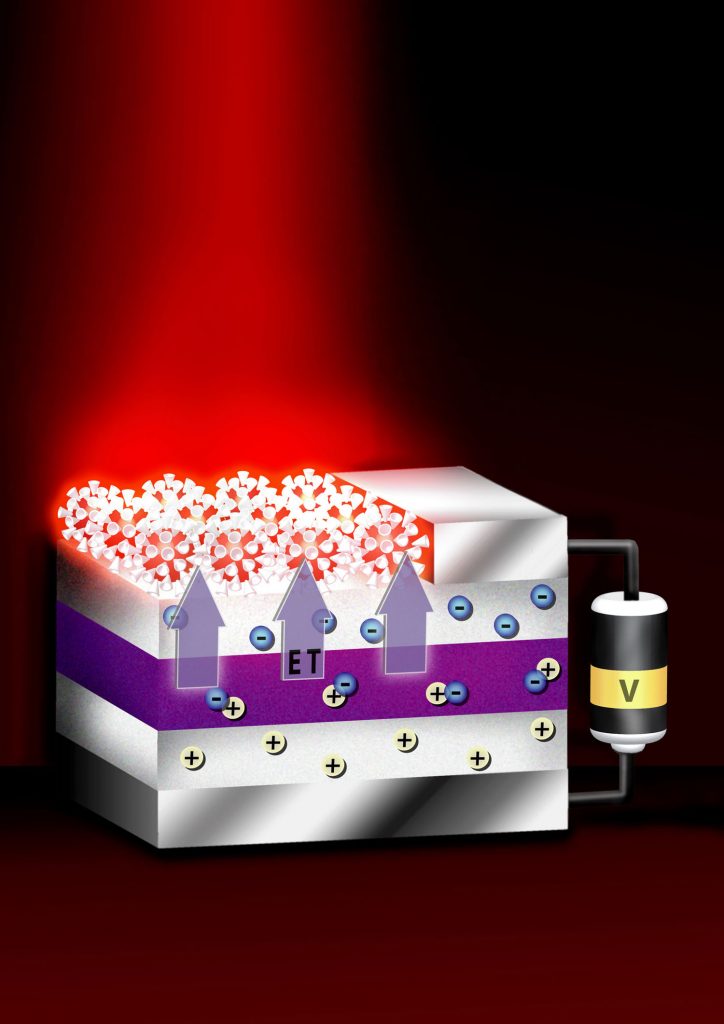
Download 300dpi JPEG image, ‘achermann7RED.jpg’, 268K (Media are welcome to download/publish this image with related news stories.)
ALBUQUERQUE, N.M. — A wireless nanodevice that functions like a fluorescent light — but potentially far more efficiently — has been developed in a joint project between the National Nuclear Security Administration’s Los Alamos and Sandia national laboratories.
The experimental success, reported in the June 10 issue of Nature, efficiently causes nanocrystals to emit light when placed on top of a nearby energy source, eliminating the need to put wires directly on the nanocrystals.
The energy source is a so-called quantum well that emits energy at wavelengths most easily absorbable by the nanocrystals.
The efficiency of the energy transfer from the quantum well to the nanocrystals was approximately 55 percent — although in theory nearly 100 percent transfer of the energy is possible and might be achieved with further tweaking.
The work is another step in creating more efficient white-light-emitting diodes — semiconductor-based structures more efficient and hardier than the common tungsten light bulb.
Reduction of lighting costs is of wide interest because on a world scale, lighting uses more electrical energy per year than any other human invention.
Nanocrystals pumped by quantum wells generate light in a process similar to the light generation in a fluorescent light bulb.
There, a captive gas permeated by electricity emits ultraviolet light that strikes the phosphor-coated surface of the bulb, causing the coat to emit its familiar, overly white fluorescent light.
The current work shows that the nanocrystals can be pumped very efficiently by a peculiar kind of energy transfer that does not require radiation in the usual sense. The process is so efficient, reports Los Alamos National Laboratory (LANL) researcher Marc Achermann, because unlike the fluorescent bulb, which must radiate its ultraviolet energy to the phosphor, the quantum well delivers its ultraviolet energy to the nanocrystal very rapidly before radiation occurs.
Because the emissions of nanocrystals (a.k.a. quantum dots) can be varied merely by controlling the size of the dot rather than by the standard, cumbersome process of varying the mix of materials, no known theoretical or practical barriers exist to pumping different-sized quantum dots that could individually emit blue, green, or red light, or be combined to generate white light.
The quantum well, about three nanometers thick, is composed of a dozen atomic layers. It coats a wafer two inches in diameter and is composed of indium gallium nitride. The film is not fabricated but rather grown as crystal, with an energy gap between its different layers that emits energy in the ultraviolet range at approximately 400 nm.
In this proof-of-principle work, the energy in the quantum well was delivered with a laser. Although the difficulties of inserting energy into the quantum well using an electrical connection rather than laser light are significant, it is considered to be feasible.
The thin-film quantum well crystal film was grown at Sandia by chemist Daniel Koleske.
“My role was small,” jokes Daniel, “but they couldn’t have done it without me.”
Sandia researchers are reputed to be among the finest epitaxial crystal-growers in the world.
LANL researchers Achermann, Melissa Petruska, Simon Kos, Darryl Smith, and Victor Klimov attached the semiconductor nanocrystals, made the measurements, and created the theory.